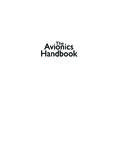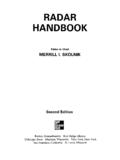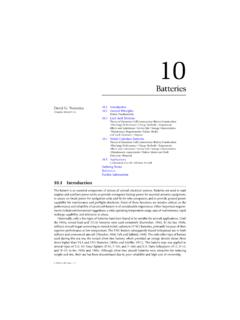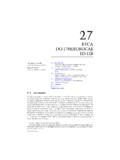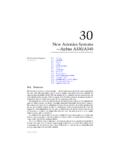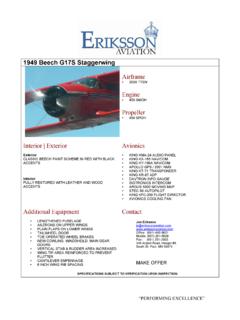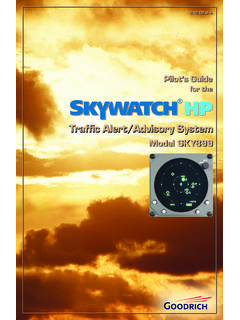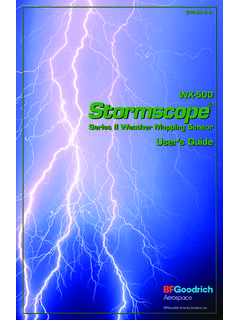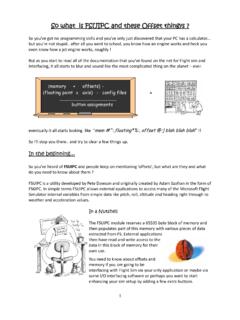Transcription of ARINC 429 - ...::: www.davi.ws
1 2001 by CRC Press LLC 2001 by CRC Press LLC 2 ARINC 429 Int roduction ARINC 419 ARINC 429 General History Design Fundamentals Message and Word Formatting Direction of Information Flow Information Element Information Identifier Source/Destination Identifier Sign/Status Matrix Data Standards Timing-Related Elements Bit Rate Information Rates Clocking Method Wo r d Synchronization Timing Tolerances Communications Protocols Development of File Data Transfer Bit-Oriented Communications Protocol Applications Initial Implementation Evolution of Controls Longevity of ARINC 429 ARINC 453 Introduction ARINC Specifications 419, 429, and 629 and Project Paper 453 are documents prepared by the AirlinesElectronic Engineering Committee (AEEC) and published by Aeronautical Radio, Inc.
2 These are amongover 300 air transport industry avionics standards published since 1949. These documents, commonlyreferred to as ARINC 419, ARINC 429, ARINC 453, and ARINC 629, describe data communication systemsused primarily on commercial transport airplanes. A limited number of general aviation and militaryairplanes also use these data systems. The differences between the systems are described in detail in thesubsequent sections. ARINC 419 ARINC Specification 419, Digital Data Compendium, provides detailed descriptions of the variousinterfaces used in the ARINC 500 series of avionics standards prior to 1980. ARINC Specification 419is often incorrectly assumed to be a standalone bus standard. ARINC Specification 419 provides asummary of electrical interfaces, protocols, and data standards for avionics built prior to the airlines selection of a single standard, , ARINC 429, for the distribution of digital information aboardaircraft.
3 Daniel A. Martinec ARINC 2001 by CRC Press LLC ARINC 429 General ARINC Specification 429, Digital Information Transfer System (DITS), was first published in 1977 andhas since become the ARINC standard most widely used by the airlines. The title of this airline standardwas chosen so as not to describe it as a data bus. Although ARINC 429 is a vehicle for data transfer, itdoes not fit the normal definition of a data bus. A typical data bus provides multidirectional transfer ofdata between multiple points over a single set of wires. ARINC 429 s simplistic one-way flow of datasignificantly limits this capability, but the associated low cost and the integrity of the installations haveprovided the airlines with a system exhibiting excellent service for more than two decades. Additionalinformation regarding avionics standards may be found at URL History In the early 1970s the airlines recognized the potential advantage of implementation of digital digital equipment had already been implemented to a certain degree on airplanes existing at thattime.
4 However, there were three new transport airplanes on the horizon. These were the Airbus A-310and the Boeing B-757 and B-767. The airlines, along with the airframe and equipment manufacturers,established a goal to create an all-new suite of avionics using digital , with digital avionics came the need for an effective means of data communications amongthe avionics units. The airlines recognized that the military was also in the early stages of developmentof a data bus that could perform the data transfer functions among military avionics. The potential fora joint program to produce a data bus common to the air transport industry and the military exhibiteda potential for significant economical benefits. The early work to develop the military s data bus was taken on by the Society of Automotive Engineers(SAE). Participants in the SAE program emanated from many parts of the military and private sectorsof aviation.
5 A considerable effort went into defining all aspects of the data bus with the goal of meetingthe needs of both the military and air transport users. That work culminated in the development of theearly version of the data bus identified by Mil-Std 1553 (see Chapter 1).Early in the process of the Mil-Std 1553 development, representatives from the air transport industryrealized that the stringent and wide range of military requirements would cause the Mil-Std 1553 to beoverly complex for the commercial user and would not exhibit the flexibility to accommodate the varyingapplications of transport airplanes. Difficulty in certification also was considered a potential decision was made to abandon a cooperative data bus development program with the military andpursue work on a data bus to more closely reflect commercial airplane single transmitter/multiple receiver data transfer systems were being used on airplanes builtin the early 1970s.
6 These proved to be reliable and efficient compared to the more complex data busesof the time. These transfer systems, described in ARINC Specification 419, were considered as candidatesfor the new digital none of the systems addressed in the ARINC Specification could adequately perform the task, eachexhibited desirable characteristics that could be applied to a new design. The result was the release of a newdata transfer system exhibiting a high level of efficiency, extremely good reliability, and ease of 429 became the industry standard. Subsequent to release of the standard, numerous low-costintegrated circuits were produced by solid-state component manufacturers. ARINC 429 was used widelyby the air transport industry and even found applications in non-aviation commercial and militaryapplications. ARINC 429 has been used as the standard for virtually all ARINC 700-series standards for digital avionics used by the air transport Radio Inc.
7 Has maintained and provided the necessary routine updates for new dataword assignments and formats. There were no significant changes in the basic design until 1980 whenoperational experience showed that certain shorted wire conditions would allow the bus to operate in 2001 by CRC Press LLC a faulty condition. The bus would operate in this condition with much reduced noise immunity. Thiscondition also proved to be very difficult to locate during routine maintenance. In response, the airlinessuggested that the design be changed in order to ensure that the bus would not continue to operatewhen this condition occurred. A change to the receiver voltage thresholds and impedances solved basic changes to the design have been made since that time. ARINC 429 has remained a reliablesystem and even today is used extensively in the most modern commercial airplanes.
8 Design Fundamentals Equipment Interconnection A single transmitter is connected with up to 20 data receivers via a single twisted and shielded pair ofwires. The shields of the wires are grounded at both ends and at any breaks along the length of the shields are kept as short as possible. Modulation Return-To-Zero (RZ) modulation is used. The voltage levels are used for this modulation scheme. Voltage Levels The differential output voltages across the transmitter output terminal with no load is described in thefollowing table: The differential voltage seen by the receiver will depend on wire length, loads, stubs, etc. With nonoise present on the signal lines the nominal voltages at the receiver terminals (A and B) would beHI to 11 VNULL to to 11V HI(V)NULL(V)LO(V) Line A to Line B 10 10 A to Ground5 5 B to Ground 5 5 2001 by CRC Press LLC In practical installations impacted by noise, etc.
9 The following voltages ranges will be typical across thereceiver input (A and B):HI to 13 VNULL to to 13 VLine (A or B) to ground voltages are not are expected to withstand without damage steady-state voltages of 30 VAC RMS appliedacross terminals A and B, or VDC applied between terminal A or B and the ground. Impedance Levels Output Impedance The transmitter output impedance is 70 to 80 (nominal 75) ohms and is divided equally between linesA and B for all logic states and transitions between those states. Input Impedance The typical receiver input characteristics are as follows:Differential Input Resistance R I 12,000 ohms minimumDifferential Input Capacitance C I 50 pF maximumResistance to Ground R H and R G 12,000 ohmsCapacitance to Ground C H and C G 50 pFThe total receiver input resistance including the effects of R I , R H and R G in parallel is 8000 ohmsminimum (400 ohms minimum for 20 receivers).
10 A maximum of 20 receivers is specified for any onetransmitter. See below for the circuit standards. Impedance The wire gauges used in the interconnecting cable will typically vary between 20 and 26 depending on desiredphysical integrity of the cable and weight limitations. Typical characteristic impedances will be in the rangeof 60 to 80 ohms. The transmitter output impedance was chosen at 75 ohms nominal to match this range. Fault Tolerance The electrical power on an airplane is provided by a generator on each engine. The airplane electrical systemis designed to take into account any variation in engine speeds, phase differentials, power bus switching,etc. However, it is virtually impossible to ensure that the power source will be perfect at all times. Failureswithin a system can also cause erratic power levels. The design of the ARINC 429 components take powervariation into account and are not generally susceptible to either damage or erratic operation when thosevariations occur.

